Mixed Impressions: a Look at the Trek Belleville WSD Mixte
Lately, readers have been asking about the Trek Belleville WSD mixte. It has been out for about a year and looks promising in pictures, but what is it like in person? I had noticed this bicycle earlier at one of my local bike shops - the Wheelworks in Somerville, MA - and recently had a chance to try it.
The Trek Belleville mixte is a "real" mixte - in the sense that it is built with twin lateral stays that extend from the head tube to the rear dropouts. The bicycle reflects the ideas of the French constructeurs (or, more likely, the contemporary builders who emulate the original constructeurs) in that it is fully equipped with fenders, front and rear racks, and dynamo-powered lighting. However, unlike classic mixtes with their elegant lines and lugged steel construction, the Trek Belleville's frame is made of a strangely thick, welded cromoly tubing. The tubing is so chunky in fact, that I was certain the bike was aluminum until I was corrected. In industry photos the chunkiness is easily disguised with good lighting and careful choice of angles. But in person, the bicycle looks like what it is: a somewhat clumsy mass-produced bike fitted with some admittedly impressive extras. Trek also promotes the "eco-design" of this model, which you can read about here.
I think that one of the most successful aspects of the Trek Belleville is the colour scheme and graphics. We like to fool ourselves into thinking that this stuff does not influence us, but it does. The slate-blue and cream colour combination with subtle red accents is harmonious, beautiful, and nostalgic. It dominates the aesthetics of the bicycle, distracting the eye from its less appealing aspects.
Trek also used a vintage headbadge for the Belleville, which goes nicely with the classic theme.
The Trek Belleville uses a threadless stem and Porteur-style handlebars. Both the stem and the handlebars are painted body colour, which is nice. A Porteur-style front rack is attached to the fork.
Close-up of the stem, grips, shifter and the points where the lateral stays attach to the head tube. While I do not normally like threadless stems and integrated handlebars, I think here the look is appealing. However, the design makes it impossible to adjust stem height and the angle of the handlebars, which is problematic.
The front rack is quite elegant, as well as smoothly integrated with the body of the bike. The tires are Bontrager, cream with black sidewalls.
The rear rack is nice as well. I don't remember the weight rating, but it was considerable. One thing I noticed, is that the attachment points are set back from the rear dropouts - presumably because the chainstays are otherwise not long enough to accommodate a rack?
The Trek Belleville is fitted with an internally geared hub (Shimano Nexus 3-speed), caliper brakes, a decent-looking crankset, touring-style pedals, and a body-coloured chainguard.
The front dynamo hub is a Shimano (I did not see the model name), and the lights used are Spanniga. The headlight is a Spanniga Micro, mounted on right stay of the front rack.
The tail light is a Spanniga Eclipse, attached to the rear rack. I have not tried the lights, as it was daytime, but I have heard good things about these models.
The saddle has a faux-handsewn leather look to it and feels like a typical padded vinyl saddle. I have read that it was designed to be disassembled and recycled after use, though I am not clear on the details.
The Trek Belleville mixte comes in two frame sizes - 43cm (17") and 50cm (20"). I am fairly certain that I tried the smaller frame, because I had to raise the saddle half a foot from its original position in order to ride the bike (note that the pictures here show the original position, not the raised position). However, while the seat tube was short, the rest of the bicycle seemed quite large. The step-over was high and bringing my leg over took some careful negotiating. And the reach from the saddle to the handlebars was characteristic of a larger frame.
I would estimate the weight of the Belleville mixte around 35lbs. Very reasonable, considering the steel tubing and all the extras.
Preparing to test-ride the bike, I walked it off of the sidewalk curb - at which point it made loud clunking noises. Upon investigation, we discovered that the fenders were wobbly - and the cause seemed to be in the design of the attachment points, rather than in the assembly. This could be an issue when riding over bumps or potholes.
I test-rode the Trek Belleville mixte briefly, and I apologise for my disgraceful "salmoning" - it was only done for the photo. As reflected in the picture, the first thing I noted was the unusually generous width of the handlebars - I almost felt as if I were holding the edges of a hula hoop. Maybe this was the cause of the strange feel to the steering, because I found the front end to be "aloof" - almost as if it was receiving its steering instructions via a third party rather than from me directly. I wonder whether it would handle differently with a front load, but that is not something I was able to test. Otherwise, the ride felt okay - with the exception perhaps of too much pressure on my hands despite the upright handlebars.
Of all the other bicycles I have test ridden, the Trek Belleville mixte is the most similar to the Specialized Globe Haul I tried last year. Both feature mixte-style construction and integrated racks, and are roughly in the same price range. Comparing the two, my impression is that the Globe Haul's construction is of somewhat better quality and I preferred the feel of the Globe's ride. In pictures and from a distance, the Trek Belleville comes across as a prettier and more classic-looking bicycle, but in person this is not so. As for comparing the Trek Belleville WSD to traditional, classic mixtes - there is something clumsy about the Trek, as a result of which it does not resemble the real deal despite the twin-stay construction.
The racks on the Trek Belleville mixte are impressive, and the fact that dynamo lighting comes standard on this bicycle is nothing short of amazing. The gorgeous paint job is also to be commended. But despite all the extras, the bicycle has an awkward and flimsy feel to it in person. The current retail of the Trek Belleville mixte is around $650, and the Wheelworks in Somerville has it on sale at the moment for a lower price. Regardless of what I think of the Trek Belleville, one thing is for sure: A production bicycle with racks and dynamo lighting is a step forward for the industry that is in itself worth applauding.
The Trek Belleville mixte is a "real" mixte - in the sense that it is built with twin lateral stays that extend from the head tube to the rear dropouts. The bicycle reflects the ideas of the French constructeurs (or, more likely, the contemporary builders who emulate the original constructeurs) in that it is fully equipped with fenders, front and rear racks, and dynamo-powered lighting. However, unlike classic mixtes with their elegant lines and lugged steel construction, the Trek Belleville's frame is made of a strangely thick, welded cromoly tubing. The tubing is so chunky in fact, that I was certain the bike was aluminum until I was corrected. In industry photos the chunkiness is easily disguised with good lighting and careful choice of angles. But in person, the bicycle looks like what it is: a somewhat clumsy mass-produced bike fitted with some admittedly impressive extras. Trek also promotes the "eco-design" of this model, which you can read about here.
I think that one of the most successful aspects of the Trek Belleville is the colour scheme and graphics. We like to fool ourselves into thinking that this stuff does not influence us, but it does. The slate-blue and cream colour combination with subtle red accents is harmonious, beautiful, and nostalgic. It dominates the aesthetics of the bicycle, distracting the eye from its less appealing aspects.
Trek also used a vintage headbadge for the Belleville, which goes nicely with the classic theme.
The Trek Belleville uses a threadless stem and Porteur-style handlebars. Both the stem and the handlebars are painted body colour, which is nice. A Porteur-style front rack is attached to the fork.
Close-up of the stem, grips, shifter and the points where the lateral stays attach to the head tube. While I do not normally like threadless stems and integrated handlebars, I think here the look is appealing. However, the design makes it impossible to adjust stem height and the angle of the handlebars, which is problematic.
The front rack is quite elegant, as well as smoothly integrated with the body of the bike. The tires are Bontrager, cream with black sidewalls.
The rear rack is nice as well. I don't remember the weight rating, but it was considerable. One thing I noticed, is that the attachment points are set back from the rear dropouts - presumably because the chainstays are otherwise not long enough to accommodate a rack?
The Trek Belleville is fitted with an internally geared hub (Shimano Nexus 3-speed), caliper brakes, a decent-looking crankset, touring-style pedals, and a body-coloured chainguard.
The front dynamo hub is a Shimano (I did not see the model name), and the lights used are Spanniga. The headlight is a Spanniga Micro, mounted on right stay of the front rack.
The tail light is a Spanniga Eclipse, attached to the rear rack. I have not tried the lights, as it was daytime, but I have heard good things about these models.
The saddle has a faux-handsewn leather look to it and feels like a typical padded vinyl saddle. I have read that it was designed to be disassembled and recycled after use, though I am not clear on the details.
The Trek Belleville mixte comes in two frame sizes - 43cm (17") and 50cm (20"). I am fairly certain that I tried the smaller frame, because I had to raise the saddle half a foot from its original position in order to ride the bike (note that the pictures here show the original position, not the raised position). However, while the seat tube was short, the rest of the bicycle seemed quite large. The step-over was high and bringing my leg over took some careful negotiating. And the reach from the saddle to the handlebars was characteristic of a larger frame.
I would estimate the weight of the Belleville mixte around 35lbs. Very reasonable, considering the steel tubing and all the extras.
Preparing to test-ride the bike, I walked it off of the sidewalk curb - at which point it made loud clunking noises. Upon investigation, we discovered that the fenders were wobbly - and the cause seemed to be in the design of the attachment points, rather than in the assembly. This could be an issue when riding over bumps or potholes.
I test-rode the Trek Belleville mixte briefly, and I apologise for my disgraceful "salmoning" - it was only done for the photo. As reflected in the picture, the first thing I noted was the unusually generous width of the handlebars - I almost felt as if I were holding the edges of a hula hoop. Maybe this was the cause of the strange feel to the steering, because I found the front end to be "aloof" - almost as if it was receiving its steering instructions via a third party rather than from me directly. I wonder whether it would handle differently with a front load, but that is not something I was able to test. Otherwise, the ride felt okay - with the exception perhaps of too much pressure on my hands despite the upright handlebars.
Of all the other bicycles I have test ridden, the Trek Belleville mixte is the most similar to the Specialized Globe Haul I tried last year. Both feature mixte-style construction and integrated racks, and are roughly in the same price range. Comparing the two, my impression is that the Globe Haul's construction is of somewhat better quality and I preferred the feel of the Globe's ride. In pictures and from a distance, the Trek Belleville comes across as a prettier and more classic-looking bicycle, but in person this is not so. As for comparing the Trek Belleville WSD to traditional, classic mixtes - there is something clumsy about the Trek, as a result of which it does not resemble the real deal despite the twin-stay construction.
The racks on the Trek Belleville mixte are impressive, and the fact that dynamo lighting comes standard on this bicycle is nothing short of amazing. The gorgeous paint job is also to be commended. But despite all the extras, the bicycle has an awkward and flimsy feel to it in person. The current retail of the Trek Belleville mixte is around $650, and the Wheelworks in Somerville has it on sale at the moment for a lower price. Regardless of what I think of the Trek Belleville, one thing is for sure: A production bicycle with racks and dynamo lighting is a step forward for the industry that is in itself worth applauding.

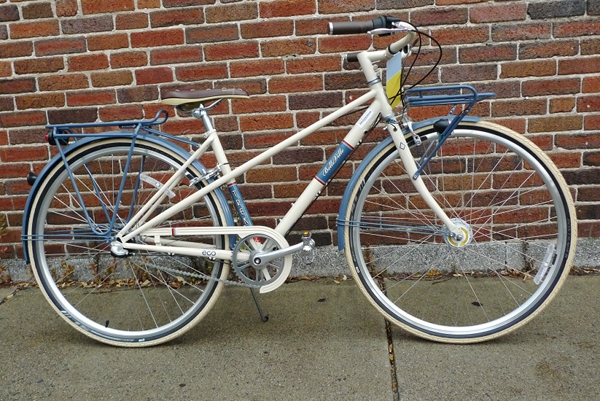
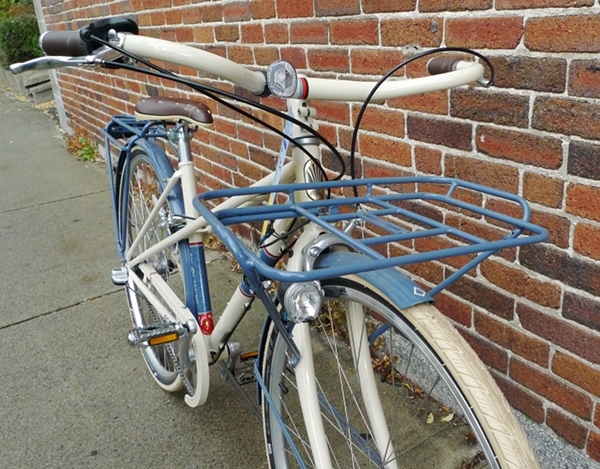
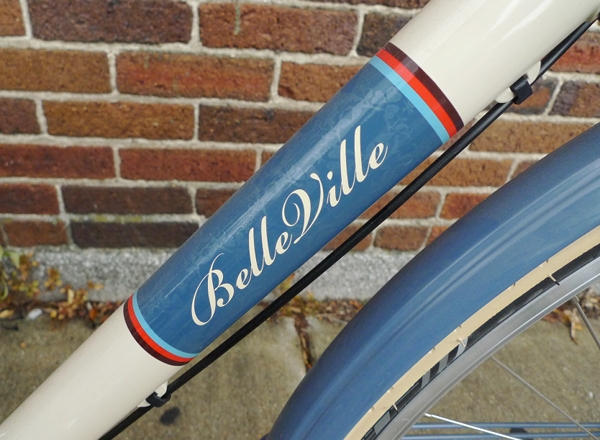



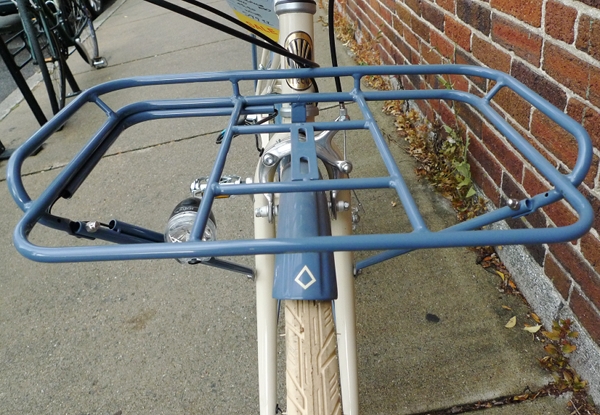


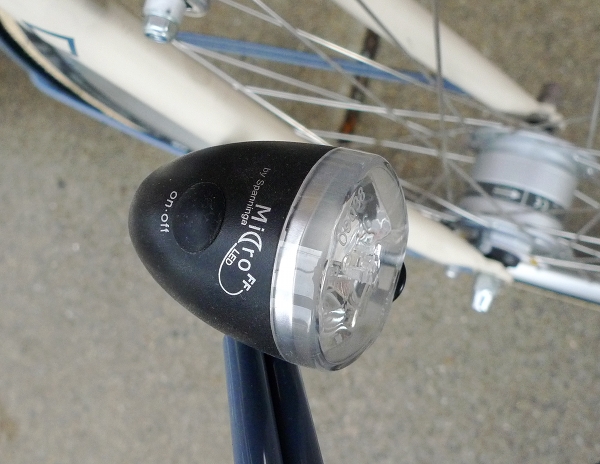

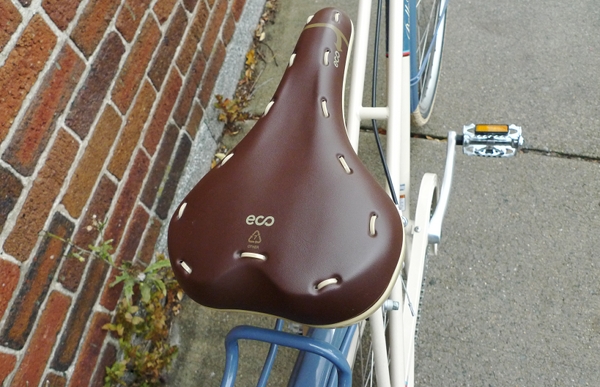
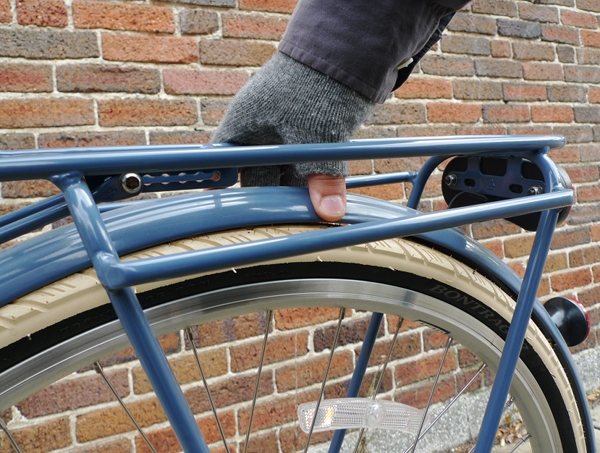
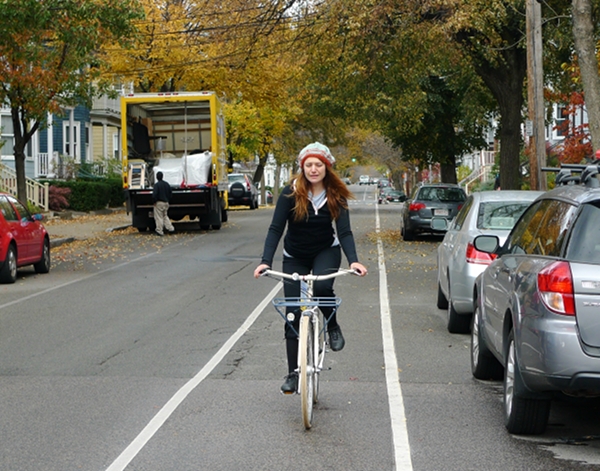
Thanks for the review. I work for a Trek Dealer and wanted to correct you at least where the frame material is concerned. It is in fact steel, and you can read the specs here. http://www.trekbikes.com/us/en/bikes/urban/eco_design/bellevillewsd/
ReplyDeleteThe bike is intended to be fully recycled at the end of its life, and thus the steel construction and many of the other details. I agree with you that it is a step in the right direction, but leaves a bit to be desired.
Brad - Wow, my bad on the aluminum mistake! I apologise and have changed the text. I have looked at the specs too, but must have "seen" aluminum because I was so sure it was, based on how the tubing looked and felt. I will add more on the recyclable aspect too.
ReplyDeletenice review. did you get a chance to test it with front and rear loads? the aloof steering may be a consequence of a low-trail fork designed for carrying loads. it's possible that with a small load in front, the steering would feel more stable.
ReplyDeleteas for the oversized tubing, i agree that it detracts from the overall aesthetic, but i wonder if the decision to go with OS tubing is rooted in a high carrying capacity? it seems that your review of the bike is coming from an expectation of a classical mixte first, cargo bike second (based largely on reporting on it without a load), but i wonder if the bike's intention is the other way around? the bike really seems more to me like a mixte-framed porteur. i don't know how trek is marketing the bike, but this is the impression i'm getting strictly from looking at the bike. and in that sense, it seems to me that a heavy duty bike with heavy duty racks, fenders, and dynamo lighting for under $650 is a bargain, all clunkiness aside. do you know how much the bike weighs?
also, as an aside, every time i've test-ridden a bike from wheelworks, i've taken it around the block (willow->summer->banks->elm) to avoid any cycling etiquette violations :-). and if you continue farther on summer, you have a nice hill to include in the test ride.
oh, one more comment about the belleville: i find that integrated bar/neck/stem combo a little irksome. it means that the bars are essentially non-adjustable (angle or height), and if you ever wanted to swap them out, you'd have to replace the stem and neck as well.
ReplyDeletesomervillain - As I wrote, I was not able to test the bike with a load and my ride was short. My impression is that the Belleville is presented as a classic bicycle with some cargo capacity, but not a "cargo bike". I would call it a Porteur, yes, but then, I would not say that a Porteur is a "cargo bike" either, and would not expect for it to handle strangely without a front load. Specs list the trail as "8.1", which confuses me. What does that number refer to? It can't actually be the mm figure, can it?
ReplyDeleteI think before you form an impression of its "heavy duty"-ness, you ought to see the bike for yourself. In fact you're close to the shop, so I'd be curious what you think. The Co-Habitant was eager for us to look at these bikes and thought they seemed great, until he saw it in person.
As for the stem though, I actually like the design. I think a threadless stem can look good in some cases, and they did a nice job.
Thanks for the review - as reviews on this bike are rare. I also think the Belleville is a good effort, but with some issues. The buyer had better like the fixed stem and bar position. The 69 degree head and 71 degree seat tube intrigue me because it is close to my favorite 1972 Schwinn Collegiate geometry. The tubing looks oversize on the mixte, perhaps not as much so on the mens frame. The stylish crankset appears to be one that the chainring is not replaceable (disposable?). The 3-speed gearing is a rather high 46 / 63 /86 according to Sheldon's IGH calculator. In contrast the Breezer Uptown 3 has 38 / 52 / 72.
ReplyDeleteIt sounds like one of those auto models "inspired" by a classic. Lack of dynamo lighting is the only drawback of our Gary Fisher "Simple City 8" which cost us less than the Trek.
ReplyDeleteBob - It is funny, because reading the specs I find some aspects of them to be at odds with my experience of the ride. For example, given the slack seat tube angle, it is surprising that the bicycle seemed to thrown me forward onto my hands. And the gearing did not seem high to me at all, if anything on the low side. For a bicycle meant to transport weight, high gearing does seem to be an odd choice.
ReplyDeleteI think reviews of this bike are rare for a reason. It is a mixte, so it is probably meant to appeal mainly to women, even thought hey call it unisex. But the high step-over and unusual handling may be discouraging mixte-seeking women from buying it.
velouria said: "As for the stem though, I actually like the design. I think a threadless stem can look good in some cases, and they did a nice job. "
ReplyDeletei do agree that it looks clean, but at the cost of adjustability. there are plenty of threadless stems out there that still look good (look at any ANT bike) but don't sacrifice funcitonality.
the 8.1 refers to cm of trail... wow. that's pretty high for a bike with such a large and inviting front rack.
also, i just noticed-- the dynamo wiring is internally routed inside the frame! nice touch, especially at that price point!
i should go test it out after picking up some groceries in porter square!
incidentally, trek refers to the mixte as "women's" and the (kinked) diamond frame version as "men's". yet the geometries are very similar.
somervillain said...
ReplyDelete"the 8.1 refers to cm of trail"
Oh!... 81mm trail?? That did not even occur to me, as I assumed the trail would be low.
I have one of those Spanninga tail lights, and they're not terribly bright. The reflectors are quite good, but the single LED really doesn't produce might light.
ReplyDeleteSteve - The lack of dynamo lighting is a huge minus, because to add it later, you need to pay for spokes, labor, and the retail mark-up on parts. About $100.
ReplyDeleteVelouria - Some of your links don't work.
ReplyDeleteLinks fixed, I think. Stupid blogspot.
ReplyDeleteVelouria - You should check your posts from the previous days too, some of the links in them were broken too.
ReplyDeleteV., I'm interested that you chose to review this bike because, compared to your custom-fitted mixte, it is bound to fall short. That is: it's not a "lovely" bicycle.
ReplyDeleteAnne - I think that most bicycles would fall short compared to a hand crafted fully custom bicycle made 5 minutes from my house by a spectacular bicycle builder.
ReplyDeleteI am not reviewing the Trek according to those standards, but to the standards of other mass-produced bicycles. I do occasionally review budget bikes (see my test ride reports of the Specialized Globe and the KHS Green, for instance). The reasons for choosing a particular bike have to do with my own curiosity, readers asking about them and availability.
Anne - The problems with this bike have little to do with it not being a custom-fitted bike.
ReplyDelete- The handlebars should be further back and tilted down. Not a matter of custom fit, but necessary given their position relative to the seat.
- Trek probably could have included brighter lights for the same price by negotiating a volume discount.
- Additional fender stays could have been added at minimal cost.
- Geometry and handling could have been designed better by copying a vintage bike. My guess is that Trek simply has little experience with this kind of bike and let a computer do most of the work.
Remember, Rivendell bikes are *not* custom fitted and could be mass produced and sold cheaply. They would still have the great handling and comfort, if not the fancy lugs and nice paint.
Thanks for another fine review. I think it's great an option such as this is now available to the mass market. It would have seemed unimaginable a few years ago.
ReplyDeleteHerzog - On the specs page on Trek's website, they have a video "documenting" the process of this bicycle being designed. There is footage of the designers referring to "vintage porters" and browsing pictures of porteurs online, including some that I recognise from various flickr accounts and blogs.
ReplyDeleteV. and Herzog - I haven't tried the bike and trust your judgment here. I've ridden a Trek touring bike for years now and throughout those years have made the adjustments to make it my "perfect" bike. But, you know, when I was young I had cheap massively heavy Cyclepro "mountain bike." I think I chose it for the beautiful turquoise color. Every summer, I rode that bike hundreds of miles throughout Nova Scotia and thought it was the best. Spoiled as I am now, I couldn't ride that bike down the street without complaining about fit, balance, components, whatever.
ReplyDeleteAs my mother would say every time I would complain about some aspect of my childhood: "It was that leaky boat that got you to shore."
Hopefully Trek figured out how to wire the lights so they don't blow up. The first generation of the Trek Belleville had the dyno lights wired incorrectly so that when you turned off the front light, the rear light would stay on and receive too much voltage from the dyno hub. The rear light would fail after a few miles. Our local dealer told customers it was supposed to be wired that way and to not turn the front light off - ever. We had to rewire and replace the rear light after his second rear light failed and the Trek dealer wouldn't acknowledge there was a defect in the way the bike was wired. Felt bad for the guy.
ReplyDeleteIt seems most of other comments have been by people who do not own a Belleville, so I will add my voice to the mix.
ReplyDeleteI have had mine for about 6 weeks now and have had a number of problems with the dynamo lights, but they have all been fixed and replaced and covered by the 1-yr warranty on all parts. Deano, your comment about the dyno lights makes perfect sense! That's probably what has happened to mine, but in my case the Trek dealer and all their mechanics that I have communicated with with have been nothing but helpful.
The front rack can carry up to 25 lbs, with an extra 50 lbs on the back. It's a better ride when more of the load is on the front, although larger loads upset the balance of the bike when parked. I also ride my Belleville anywhere between 2-20 miles everywhere around Madison and used to have rattly fenders until they were tightened up and it's not been an issue since.
I could say a lot more about the quality of the ride, fixed handlebars, "plasticy" grips, and recycled seat but they seem to have been mentioned at length by others. I will just say that the shifting is incredibly smooth (although I wish it had 7 gears like the regular model instead of 3! see V's blog post about His & Hers matching bicycles). The bike handles herself very nimbly and yet felt solid and grounded when I road her in the 20-40 mph wind storm we had last week.
Trek has started off on the right foot, and this bike helps fill a gap in the market. I'm hoping they can give these production bikes the same love they give the Project One models, keeping the price low without sacrificing the integrity of the bike and its accessories.
P.S. Someone mentioned their Gary Fisher Simple City. Now that the Gary Fisher brand is totally under the Trek roof, that line has been discontinued in order to reduce redundancy with the Belleville, Allant, and Atwood models.
Oh, interesting about the lights. I wonder it was all bikes, or just those from that specific dealer (in other words, who assembles them)?
ReplyDeleteAfter thinking about it some more, I think my overall thoughts on this bicycles are as follows:
Trek is a huge company with lots of resources. They had the resources to put an entire team of designers and engineers to work on this project and to experiment with eco-friendly methods. They used steel tubing and went through the trouble of going for a traditional twin-stay design, as well as sourcing racks and accessories. Why then, did they have to weird-ify this bicycle - both in terms of tubing/construction and in terms of geometry? I am not even talking about lugs. But why not just make a cleanly welded mixte with the same geometry as an old Nishiki or Schwinn LeTour or something, and slap the same racks and lights on that? It would be infinitely more useable and sellable, and there is no reason why it should be any more costly to produce than what they created here.
sarahgringa - Thank you for your comment! I think it is infinitely more useful to hear from an owner than anything I have to say.
ReplyDeleteI really like the look of this bike, but wish it came in larger sizes...That said, if I was in the market for a new mixte (which I'm not at the moment), I'd probably pool my money for a Soma mixte.
ReplyDeleteThe lack of handlebar angle adjustment is a big fit issue. It flat won't work for many cyclists for long-distance rides due to existing angles. If your commute is 1 mile, sure, it doesn't matter. But if you cycle 20 miles in the course of the day, then forget it.
ReplyDeleteAlso, I think this bike was a lot heavier than 30-35 lbs. I want to say 40 lbs. The racks are nice though, not gimmicky IMO. The wiring looked not haphazard at all, so I am surprised to find that they overvoltaged the rear light. But then again, it's not unheard of to wire these things incorrectly (I've had to replace a tail-light someone wired improperly). The light placement is spot-on, though, shame to hear they used dim lights. But, yet again, bright lights mean $$$. We had to pay $150 for our dynamo lights per bike. The rear fender attachments are poorly designed.
I can't comment on geometry because it was too small for me to even attempt to ride it.
And, finally, it's my fault that we thought the tubing was alloy. It just looks like it. Crazy! So big-boned. Bottom-line: uglier in person than in pictures, so even if you love it, please see and test ride before you buy. But otherwise, very good potential.
Matthew - Have you seen the VO mixte frame? It is lugged, comes in a 57mm frame size and costs just a little more than the Soma.
ReplyDeleteMDI - I think that there are two separate issues at hand:
1. the execution of this specific bike, and
2. the concept of what Trek was trying to accomplish
I would give them an A+ for point #2 and would encourage them, as well as the rest of the industry, to keep trying. But for point #1 I am afraid it would be a C-, at least to my standards. And again, I say that in the context of what I think a production bike could be, and not in the context of holding them up to higher standards.
I have. I like the VO mixte as well, but the white and gold from the Soma really gets me...
ReplyDeleteRegardless, there are options out there for the taller guys...
Ah, there! I've been saying that the VO mixte blue colour was ill chosen. Too bad; colour is important. And I agree that SOMA's cream and gold combination is nice.
ReplyDeleteMDI - "But, yet again, bright lights mean $$$."
ReplyDeleteNot really. At retail, yes. But bright lights don't really cost more to make and a company like Trek could probably negotiate a nice discount.
Before I saved up my money for a Miss Mercian, I was tempted to buy a Belleville. I, too, was taken in by website photos. Then I saw it in person, and tried it. I soon realized that there was no way I could get either the diamond or the mixte model to fit me well. And, the steering and overall handling were more sluggish than I expected them to be. Finally, one mechanic at a shop that sells them said (off the record, of course) that after assembling them, he wasn't impressed. He advised me to find an old Japanese mixte or women's bike and customize it to my liking.
ReplyDeleteStill, I'm glad that the Belleville is available. It's right for certain kinds of riders, and might get Americans more interested in more utilitarian types of bikes.
If I hadn't bought the Mercian, I probably would've gone for the VO. It's a nice frame and a good value. Plus, I like the folks at VO.
If I hadn't gotten the Mercian or VO, I probably would've gone for the Soma, which would have cost less.
I agree about the VO color. I don't dislike the color per se; I just don't think it looks good on that bike--especially with the orange decals.
On the VO Mixte - sadly the 57mm is sold-out. They don't plan on re-ordering until they get more warehouse space.
ReplyDeleteherzog said: "But bright lights don't really cost more to make and a company like Trek could probably negotiate a nice discount. "
ReplyDeletedon't you think they already negotiated a bulk price discount for the current lights? i'm sure they went over their options and sourced the best prices they could for a range of lighting options, and in the end, went for the one that would allow them to keep the bike at its present price point while being "good enough" for them. this is something that all companies as large as trek do, and they probably did it for most of the components on the bike as well. if they started upgrading all the parts on the bike, regardless of the bulk discounts, the bike would have to carry a higher price tag. that's why we have bikes that range from $100 to sky's the limit. it's why companies like shimano make a dozen different derailleurs. it's all about mass producing and mass marketing turnkey solutions to consumers at various price points to satisfy as many consumers as possible.
while they're at it, why don't they upgrade the rims and tires as well? why don't they upgrade the saddle? the crankset? the hubs? oh, and keep the price the same, please.
i think it's amazing that they have hub dynamo lighting, period, at this price point.
I don't think the dim dynamo lighting is the problem. It is probably no more dim than what is included standard on the $1,000+ Pashley, Gazelle and Batavus bikes. I think the accessories are all fine in fact, I even like the crankset. What's not fine is the "bones" and that part is, unfortunately, unfixable. If they used normal tubing and geomery, they would have had a winner.
ReplyDeleteInteresting to read the in-depth review.
ReplyDeleteI think my earlier experience with a test ride was clouded by the facts that a)I was delighted that they had given the racks, lighting, IGH, and color scheme *any thought at all*, and b) knowing that there was no way that a 49cm frame bicycle could be properly adjusted for either a 5'9" + woman or a 6'1" man, so we didn't think to really count up the deficiencies.
The shop owner considered it a good, but not great, buy, and told me so.
I still think they did very well on the color scheme, though I agree that the tubing looks a little cartoon-ish upon critical study.
Corey K
BTW Corey: We were speculating in a previous post re the inspiration of the kinked top tube on the men's model... and then I saw this on fixedgeargallery. What do you think? Looks like the same design to me.
ReplyDeleteYou mean the cat, right?
ReplyDeleteI have one and I want my money back. And I would return it if the shop where I bought it had not closed permanently the NEXT DAY.
ReplyDeleteThe lights failed literally 5 minutes after I got it home. And I mean FAILED -- fell apart. The rear fender was dented and warped. The front rack was bent. It took almost a month to get Trek to address the issues. They finally sent me a new bike, but I went through hell to get it.
WAY too many corners were cut to keep this bicycle at a low price point. I replaced: the saddle, the pedals, the fenders and the seatpost. I had a stem extender added so that the handlebars were more comfortable. The lights are not all that -- I rely on them as backup only. The rear fender rattled so badly on a road with any texture at all that it was useless.
A huge disappointment and Trek treated me so badly that I will never buy another bike from them.
alright, i gotta ask again: what's wrong with threadless stems?
ReplyDeletealso, i kept checking, and unless you flipped the pictures, i'm fairly certain that the headlight is mounted on the *right* side of the rack?
-rob
Unfortunately the bikes under a thousand aren't that good these days. Try telling that to people though who ask "how much did your bike cost?". The chunky frame is a cheap out too. While it's nice the big bike companies are building some steel steeds again, they are cheaping out or making them thick. Steel does not have to be so thick. my surly lht is very thick because it is a touring bike, but it's total overkill. my recently gifted to me trek touring bike has thin beautiful tubing. I love the vintage headbadge though and would like one for my trek as it has an ugly headbadge. I don't like the look of this belleville at all.
ReplyDeleteMy advice is: get an old lugged beautiful mixte or whatever frame and repair it or rebuild as you see fit. Resurrect the old beauties and save from landfills!
Heather
Oh no Lynne, I am sorry to hear that! But thank you for sharing your experience here. As I have said earlier, feedback from owners is more informative than my limited review.
ReplyDeleterob - Thanks on catching that, I need to work on my abstract spatial rotation skills : )
Threadless stems: On this bicycle the stem height and the position of the handlebars are fixed, which is bad if you need the height or angle to be adjusted at all.
Heather wrote:
ReplyDelete"Unfortunately the bikes under a thousand aren't that good these days. Try telling that to people though who ask "how much did your bike cost?""
You know, I was re-reading one of my early posts and in it I refer to the "shocking $800+ price tag of Dutch-style bikes". I need to remember that this is what I thought less than 2 years ago, that $800 is a *shocking* amount of money to spend on a bike. A change of attitude can only come after realising for oneself that low-cost, mass-produced bikes are what they are. Except for vintage 3-speeds of course.
rob: see my post way above re: stem and bars. it has nothing to do with being threadless, and everything with trek's decision to use a one-piece handlebar/neck/stem.
ReplyDeletevelouria, somervillain: I totally get the problem with the ridiculous one-piece design on this particular rig. I should've qualified my "question" re: threadless headsets; i was responding mostly to the general disparagement of threadless systems that are interspersed with criticisms of the one-piece in this bike. Couple different contributors, and i'm not going to single anyone out. It's just a general reminder that it seems weird to criticize things for purely aesthetic reasons, and i believe that much of the criticism directed at threadless is about aesthetics. I love threaded systems, and prefer them when buying used (so i can move the bars up or down, as needed, natch). But, as someone who rides trails, i am quite thankful for threadless systems, too. Helps keep costs down, too.
ReplyDeleteBut, in the end, i think the general consensus is that this bike is a turd. I think that has much to do with high expectations, but also to do with the general turdishness of the current new bike market. Sure, the belleville has some tragic details (not the least is the name). But, if you had 650 beans to spend, on a NEW bike, what would you buy instead? never be caught dead on a trek belleville, but i reckon it would fit many ppl's needs quite nicely.
-rob
That was an honest review. Is Trek a sponsor?
ReplyDeleteI've seen the bike, or at least a similar Trek model in the bike shop and did notice it had a stabilizer spring or 'deflopilator'. That's a feature I appreciate on a bike with a front rack capable of carrying a heavy load, though I would not make the purchasing decision based soley on this spring. This bike isn't my cup of tea, but it seems to have a good set of features for the price.
Anon 11:47 - Trek is not a sponsor. Sponsors' banners are displayed on the right hand panel and any other affiliations with manufacturers are mentioned in the review as well.
ReplyDeleterob - No, I would not use that word. First, because I do not think that bike was worse quality than 90% of the other city bikes they had on the shop floor, and second because I do not want to "punish" Trek for trying something interesting. I do not like the bike, but I don't dislike it any more than I do other bikes of its type, if that makes sense...
The movement you noticed in the rear fender flexes the wiring that goes into the rear brake light that is attached to the rack. Trek says they have not heard of it but the wiring coming apart right at the tailight connector due to the flexing is common. That's the only real problem other than no being able to adjust the handlebars that we've seen on these.
ReplyDeleteThe fender is easy to fix you need to put a bracket in to support the fender better. The handbar requires a complete changeout if you do not fit quite right.
The rear fender flopping causes another problem. The wiring for the rear tailight exits the fender and plugs into the light which is fixed on the rack. So the movement of the rear fender flexes the wiring and causes it to break after awhile. Trek has never heard of this happening but we are not the only ones who had it happen. An extra support bracket under the tail rack solved it. The handlebar fit required a new stem and handlebar to solve and actually looks quite nice, we went with a silver stem and handlebars.
ReplyDeleteI own a Belleville (diamond frame, though I am female) and recently wrote up my impressions after a few months commuting on it. IMO, for under $600 on sale, it was an incredible steal. The racks are fantastic, the ride is smooth, and the saddle surprisingly not that bad, at least for my butt. The horrific handgrips were replaced within 24 hours though. What annoys me more than anything are the fender connections that you mentioned (rear fender hardware snapped when I hit a pothole, generator wire went with it), the quality of the included generator lights, and the inherent limitations of a 3 speed hub. I'm seriously considering upgrading to an Alfine hub--the Nexus just doesn't give me the range I'd like.
ReplyDeleteAnyway, nice review! I think this bike could be great for the right person with a limited budget. It's served me quite well so far.
If you are just now reading this Trek will repair the wiring harness. If you have one the older ones with the tail light that stays lit when the headlight is off you should contact your dealer. They rewired that and replaced the burned out tailight. Sadly they did not fix the floppy fender. But they did replace the L bracket that holds it on with a heavier looking one. Maybe that will work. If not time to jerry rig something up.
ReplyDeleteJumping in late but...
ReplyDeleteI know this article and thread are way past their prime, but I didn't discover Lovely Bicycle until AFTER I bought my Gentleman's Belleville, which I absolutely love.
I should qualify that with some background, however- My last bike was a Nishiki Colorado, purchased in the mid 80's, and I haven't ridden anything else since then. Heck, I haven't ridden a bike PERIOD in 10 years.
Maybe that makes my tastes a little underdeveloped, but that doesn't change the fact that buying the Belleville has been the high point of my year.
Sure I've had some problems. I think most of them are attributable to assembly error. I don't know i that was manufacturer assembly or dealer assembly. I've found electrical connectors jammed in backwards, nuts and bolts put in backwards from what common sense would do, pieces of the rack that were swapped from one side to the other. They were all things I was able to notice and solve on my own, but they did require me to find them and solve them. Oh, and giving all of the screws and bolts a once-over tightening stopped most of the rattles.
I've built a crate for the front, a flat platform for the rear, and hung Swiss army panniers. Since I'm regularly hauling groceries I've put a steering stabilizer spring onto the front (I tried the one from Velo-Orange, but it didn't fit the massive frame tubing so I cobbled together a bit of brass to help). I've ordered a dual-leg kickstand which should make for better fully-loaded parking. I probably will add a Brooks or equivalent saddle for style and purported comfort (I've never tried one before). And I've raised the bars by about 10mm with a spacer (the manual says you can go up to 40mm, if I remember correctly).
It IS heavy. And getting heavier with all of my additions. But it feels like it could last me forever.
And at least out here in Southern California everyone absolutely loves the look of my bike. I get stares and compliments and honks and waves; Even the occasional photograph.
I've only ridden about 500 miles so far, but five months ago I hadn't ridden any in at least a decade, so I think that's a nice start.
Anyway.. What was my point? Just that I really love my Belleville. If it's actually as bad as everyone here seems to say, it sounds like I have an exciting future of bicycling ahead of me, and a lot of other great products to get to know. But in the meantime it is exactly what I want- give or take a few mods.
I bought a 2011 Belleville 59cm from International Bike in Boston yesterday. I spent a few hours riding yesterday and again today. So far, I love riding it.
ReplyDeleteToday, I parked it outside coffee shop and sat in a seat by the window drinking my joe. I couldn't help but notice passers-by stopping to stare at my Belleville on the rack. The color scheme and design is striking and attracts admirers.
im 5'7 so what size of bike should i buy for belleville?
ReplyDeleteHello Velouria !
ReplyDeleteWhere do I order Trek Bellville online ?
None of stores I referred has it in stock !..
I want it very much.
Please, would you tell me through e-mail: pa22@yandex.ru.
Thank you !
I have owned a Belleville and have ridden it and find the ride harsh and the handlebars awkward. Its probably ok for a 2 mile ride to the grocery store and probably has storage to return home but that is not my riding style. I would also agree with the author that it looks much better in the pictures, I bought the pictures which make the bike look simple and well designed and received something that looks and weighs quite clunky. Its simply not made for any distance.
ReplyDeleteHey, Velouria, did you know Gothamist made you the sorta poster child of salmoning?: "In Defense of Cyclist Salmoning" (June 21, 2013, http://gothamist.com/2013/06/21/in_defense_of_salmoning_on_a_bike.php). Aw, heck, why bother with context or respecting copyrights when there's an Important Point to be made.
ReplyDeleteI enjoy your blog. Exactly what I needed when shopping for my first bike in 35 years. I was starting to think nobody got it - that some folks are just looking for an errand bike or comfy cruiser, something personal that fits us. Your observations are a refreshing change from the often tiresome confrontational web forum vibe.